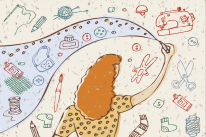
“Our sorrows and wounds are healed only when we touch them with compassion.” ~Buddha
He had been ignoring the symptoms for months, possibly even a year. When my husband came home from the doctors, he told me his PSA score was high, and he needed to have a biopsy. That date came and went, and we were waiting for the pathology report.
The doctor assured us it was nothing.
The image of standing in the car dealership parking lot, talking with my son and son-in-law will be forever etched in my memory. When the phone rang, I saw that it was he, and expecting it to be good news that I could share with my family, I answered it quickly.
These were the words that I heard: “It’s not good; I have cancer.”
Still holding the phone to my ear, I looked at my son. A million thoughts were racing through my mind. Should I tell him? I felt the weight of my husband’s words pressing me into the pavement.
My son and son-in-law were carrying on their conversation as if the world had not stopped. In my mind, it had. How surreal.
As I lowered the phone to my side, and I said, “Dad has cancer.” From that moment on, life as I knew it changed. I am well acquainted with the definition of sadness.
“Sadness is emotional pain associated with, or characterized by feelings of disadvantage, loss, despair, hopelessness, and sorrow. An individual experiencing sadness may become quiet or lethargic, and withdraw themselves from others. Crying is often an indication of sadness.” ~Wikipedia
Over the past three years I have had to make multiple adjustments to the story I had envisioned for my life.
I have a beautiful mobile with birds carved out of driftwood. It was as if someone had flicked one of the birds, sending the others (still tethered together) flying in all directions.
Just as the birds seemed to settle down, they got flicked again, and then again, and then again.
Did you know grief is an actual physical process that our brain goes through after a significant change?
The limbic system in our brain holds an internal image of life as we know it. When a major change takes place, new neuropathways must be built in order to accommodate an updated version of reality.
Building a new picture literally takes a lot of energy and time depending on the nature of the change.
If we didn’t understand that grieving is a necessary process in order to move forward, we might become impatient and want to skip this unpleasant period of time.
Numbness, shock, feeling unsettled, and sadness are among the symptoms of grief.
Out of the hundreds of emotions we experience, sadness is one of the basics.
From a survival perspective, it has been said that sadness was hardwired into us to keep us safe after significant loss. It is associated with a feeling of heaviness, sleepiness, and withdrawal from activity and social connections.
That makes perfect sense when you consider that grief (or the time your brain is updating) causes impaired short-term memory, decreased concentration and attention span, absent-mindedness, forgetfulness, and distraction.
After a major loss it would be unsafe to go hunting or gathering.
Having said that, sadness remains the one emotion people try to avoid the most, and understandably so. To be sad is to be vulnerable, and again, from a primitive perspective, this is a threat to our very survival.
We need to remind ourselves that our minds have evolved, and though it is unpleasant, we can survive sadness. Not only can we survive sadness, it can be our teacher if we let it.
It is impossible to think of any benefit of sadness while in the midst of it, but pondering it before the fact can go a long way in lessening the blow when it occurs. Understanding is powerful.
We can’t make sadness feel good, but we can navigate it better and even learn from it.
What Can Be Learned from Sadness?
- Sadness can help clarify our identity by showing us what we value.
- If we are mindful of the visceral sensations of sadness, we become aware it is an emotion; it’s not who we are.
- It is a signal that we are processing something we don’t want to let go of. We can explore our attachments from a non-judgmental stance.
- As we become acquainted with sadness, we are able to have empathy for others, which strengthens our connections.
- We are better able to appreciate the good times when we have something to contrast it with.
- When we have the courage to handle sadness, we expand our capacity to handle other hard things.
- When we honor our sadness, we learn that passing through it is expedited.
“Getting over a painful experience is much like crossing monkey bars. You have to let go at some point in order to move forward.” ~C. S. Lewis
Navigating Sadness
1. Identify the source of your sadness.
Emotions have more power when their triggers are kept secret. Name what is making you sad. It doesn’t have to be one thing.
2. Determine if it is justified.
Do yourself a favor and ask if what your sad about is true. If it is not, let it go. Usually if you are sad it is legitimate, even if the reason isn’t what you thought it was to begin with.
3. Validate your emotion.
Allow yourself to feel sad. What you are feeling is real.
4. Practice self-compassion.
Show yourself some love. Don’t be angry with yourself. In Tara Brach’s words say, “It’s okay, sweetheart.”
5. Accept.
Unconditionally accept your new reality. You don’t have to like it, approve of it, or give life a pass. Acceptance allows you to manage change more effectively.
6. Create a survivor’s picture.
Paint a new picture of your life with you being a courageous survivor. Find the meaning in your suffering.
7. Remember that every day deserves a new picture.
Stay in the here and now, and allow a new picture to unfold each day. When you are flexible enough to allow for small changes regularly, big changes, though shocking, are easier to handle.
—
Navigating rather than running from sadness has deepened my perspective on life. It has helped me savor time with loved ones, be more compassionate with others who might be struggling, and not become unsettled over small things.
It has taught me that I have little control over what comes to pass in my life, but I have courage to pass through hard times, knowing the sun will shine again, if I allow it.
Most of all, I have learned that time and being compassionate toward myself are the most reliable healers.
I can feel vulnerable and still know I will survive.
Disclaimer: This article is in reference to non-depressive sadness. If you have been excessively sad for an extended period of time for no apparent reason, please seek professional help.
Photo by Anders Ljungberg
About Barbara Scoville
Barbara Scoville is a licensed clinical social worker practicing psychotherapy in Salt Lake City, Utah. She is passionate about cultivating resilience and combines both Eastern and Western Philosophy into her practice. Check out her blog at www.barbarascovillelcsw.com for an eclectic boost of wisdom and encouragement.













 Though I run this site, it is not mine. It's ours. It's not about me. It's about us. Your stories and your wisdom are just as meaningful as mine.
Though I run this site, it is not mine. It's ours. It's not about me. It's about us. Your stories and your wisdom are just as meaningful as mine. 